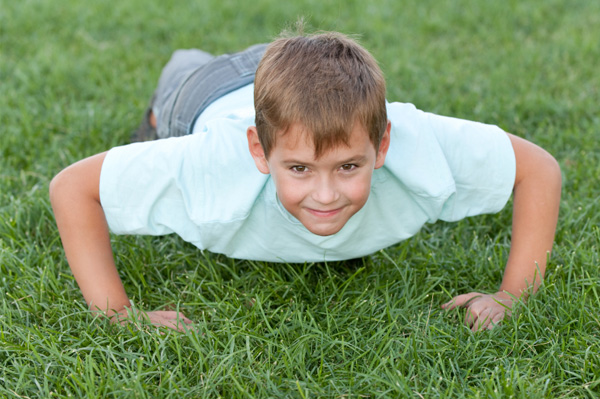1. Hopping
Key Phrase: "Two feet together."
Set a landmark, and get the child to hop there and back. This input will compress his joints and help him know where his body is in space.
2. Skipping
Key Phrase: "Knees to hands."
This activity uses both sides of the brain, and is really hard for some kids. If they struggle, physically help them by tapping which leg and arm she will be using. Also, putting her hands out for the knees to hit on their way up will provide a stepping stone to successful skipping.
3. Jumpin' Jacks
Key Phrase: "Clap hands over your head."
Some kids do very small Jumpin' Jacks, and others have trouble counting 1:1 per jump. If you get the child to clap over his head, you'll most likely get a more complete jump from him, and also the clap will provide sensory input.
4. Push Ups
Key Phrase: "All the way to straight arms."
Some children with sensory sensitivities may also have physical problems where they have low tone, or don't extend their arms fully. Without having her "lock" her arms, encourage full push ups rather than a certain quantity.
5. Planking
Key Phrase: "Butt down."
Many kids will want to poke their butts in the air while planking. If he's finding it hard, encourage him that it's meant to be difficult to plank. Strengthening the core will make it easier for a child to sit still.
6. Downward Dog
Key Phrase: "Hands flat, butt up".
For children who seem to be preoccupied by playing with their hands, downward dog provides the input that can help temporarily curb this behavior. Also downward dog will build her bone density, wake her up and boost circulation.
7. Growing Seeds
Key Phrase: "Grow from a seed to a flower."
Have your kids go as small as possible, and grow as tall as possible - all in slow motion. Some kids go from 0-100 really quickly in everything they do - sensory seekers tend to go from whisper to yell, happy to infuriated, calm to hyper - in a matter of moments. This activity helps them establish "shades of grey" within their behavior.
8. Bean Bag Toss
Key Phrase: "1...2...3"
Grab two beanbags and two people, set yourselves at least shoulder-width apart and throw the beanbags simultaneously. Aim for certain amount of catches, and don't acknowledge the misses. Builds hand-eye co-ordination.
9. Hoops
Key Phrase: "Switch Arms."
Teach your child to spin a hoop on his arm, and switch it to the other arm. This uses both sides of the brain, on top of mastering a skill of hand-eye co-ordination. Excellent to use before a child needs to sit for a while and pay attention.
10. Weight Lifting
Key Phrase: "(Chair) to (the fence)."
Find the heaviest kid-friendly weight available and have her carry it to a landmark. At the airport, get your kids to roll the suitcases for you. At school, have her lift a chair. Find something heavy and go with it! When the muscles work hard, the child with sensory sensitivities will be more focused.
11. Cross Crawls
Key Phrase: "Touch elbow bone to kneecap."
Again, this activity uses both sides of the brain and gets kids ready to learn.
12. Fast & Slow
Key Phrase: "Really fast for 20 seconds, really slow for 20 seconds."
Get their energy out by moving really fast first, then calm them down by challenging them to change track and move slow.
13. Running
Key Phrase: "To (there) and back."
Nothing fancy, just run!
14. Drawing
Key Phrase: (None, perhaps set a time limit)
This can be really relaxing. Some kids like to write their name, some kids like to write numbers and others regulate themselves by doodling.
15. Silent Celebrations
Key Phrase: "Silent means no noise."
Kids might want to run around like they're celebrating, or even have a real accomplishment to celebrate. Either way, teach them to do it silently and see how much fun they can have without being overstimulated with sound.














No comments:
Post a Comment